“Omicron” Predated SARS-CoV-2 Wuhan by Years
Perhaps American citizens turned out to not be as naïve or easily misled as the WHO, global Marxism, China, and The Party had anticipated
Evidence which cannot be ignored or dismissed by competent science, regarding the preexistence of a proto-form of COVID-19—later misleadingly designated as a singular variant, “Omicron”—is presented below. This evidence demands scrutiny and incorporation into any valid hypothesis addressing the origins and evolution of SARS-CoV-2.
We contend that, based on ample, consilient, and diverse deductive evidence, the series of widely varied background viruses first identified in November 2021—and misleadingly labeled as the single variant, “Omicron”—were, in fact, the background set of SARS-CoV-2a viruses. These viruses trace their common ancestor to a time over two years prior (July 2017) to the emergence of SARS-CoV-2b Wuhan, initially detected on November 17, 2019, in Wuhan, China.1
Deductive evidence, by its nature, imposes a Duty to Address and Inform on all valid hypotheses, requiring them to coherently explain the observation. While inductive evidence may be set aside as circumstantial or suggestive, deductive evidence carries a higher burden: it demands acknowledgment and integration into the composition or claims of any valid hypothesis. Deductive evidence compels scientific theories to adapt, refine, or risk invalidation. A hypothesis that fails to incorporate or address such evidence forfeits its validity.
For example, while the sun is observed to rise in the east each day and move across the sky, this merely suggests a pattern and not a specific conclusion. As inductive evidence, it was a helpful observation with a very high intrinsic ‘p-value‘ if you will. However, one could still argue it only suggested apparent movement. The enforcement of geocentrism as the ‘simplest explanation’ by science at the time was, therefore, invalid, as it relied too heavily on observational patterns without addressing the broader deductive framework.
In contrast, Galileo’s observation that Venus exhibits phases of illumination, similar to those of the Moon and Earth, constitutes deductive evidence. This finding directly falsified the Ptolemaic model and placed a mandatory burden on all valid cosmological hypotheses to incorporate the movement of planets into their theoretical framework. This was no longer an observation that could be ignored or dismissed—it demanded integration or refutation.
Such evidence, which “cannot be ignored or dismissed” by competent science, regarding the preexistence of a proto-form of COVID-19—later misleadingly designated as a singular variant, “Omicron”—is presented below. This evidence demands scrutiny and incorporation into any valid hypothesis addressing the origins and evolution of SARS-CoV-2.
Furthermore, the study of 35 recombinant isolates of Omicron variants BA.1 and BA.2 confirmed that Omicron variants were already present in 2020.
~ Tanaka, et al. “Unnatural evolutionary processes of SARS-CoV-2 variants and possibility of deliberate natural selection” Aug 20232
A. Prior Immunity to COVID-19: The December 2019 Footprint
The global distribution of deaths per million by nation from COVID-19, as illustrated in Exhibit 1 below, indicates a striking pattern consistent with a proto-Covid prior immunity footprint that predates the initial reported outbreak of the virus in December 2019.
This immunity, evident in distinct geographic regions, follows a gradient resembling the historical pathways taken by seasonal flu and cold viruses, which tend to show variability in population exposure and immune response over time.
Nations in Zone I, with the lowest death rates, display an inelastic relationship between their population size and the number of deaths, suggesting robust preexisting immunity. In contrast, Zone III nations exhibit disproportionately high death rates, indicative of naïve populations with little or no prior exposure to a SARS-CoV-2 related pathogen. This distribution underscores the hypothesis that SARS-CoV-2, or its ancestral forms, circulated well before the officially recognized outbreak in December 2019, conferring varying degrees of immunity across global populations long before the pandemic was formally identified.
Obesity and population aging progression lines are included to illustrate their mild association with COVID-19 mortality. However, these factors fail to account for the dramatic 47:1 taper in mortality observed across nations globally. This stark gradient in mortality statistics can only be explained by the presence of prior immunity, which imparts a signal of this magnitude and clarity into the data.

B. The Relative Mutational Breadth and Depth of Omicron: Evidence of a Much Older Ancestry
Omicron’s genetic divergence reveals a timeline and complexity that directly challenge the narrative of its sudden emergence in November 2021. Through applying a Boruvka’s Minimum Spanning Tree (MST) model, we analyze both the vertical genetic distance (mutations relative to ancestral strains) and horizontal distance (divergence among Omicron substrains). This model, weighted by nucleotide entropy (frequency of mutation for a specific nucleotide pair bond site), demonstrates that the breadth and depth of Omicron’s genetic variation necessitate a long evolutionary timeline—one that predates the emergence of the Wuhan strain (SARS-CoV-2b) by at least two years.
One can observe the impressive breadth of “Omicron,” already extant upon its first detection in November 2021, in this nextstrain.org chart. The allele matching table derived as part of this analysis can be seen by clicking here. For an explanation of how entropy is used to weight this genetically-derived clock time, click on this image.
The analysis traces Omicron’s most recent common ancestor (MRCA) back to July 2017, with branching lineages such as BA.1 and BA.2 appearing as early as 2018. These substrains not only show extensive mutations from Wuhan but also display significant divergence from each other, suggesting they evolved independently over time. Such a wide horizontal and vertical genetic spread makes it genetically implausible for Omicron to have emerged de novo in late 2021. Instead, this evidence supports the hypothesis of a long-standing, independent evolutionary lineage for Omicron, hidden in the background until its detection. The following graphic illustrates this critical point.
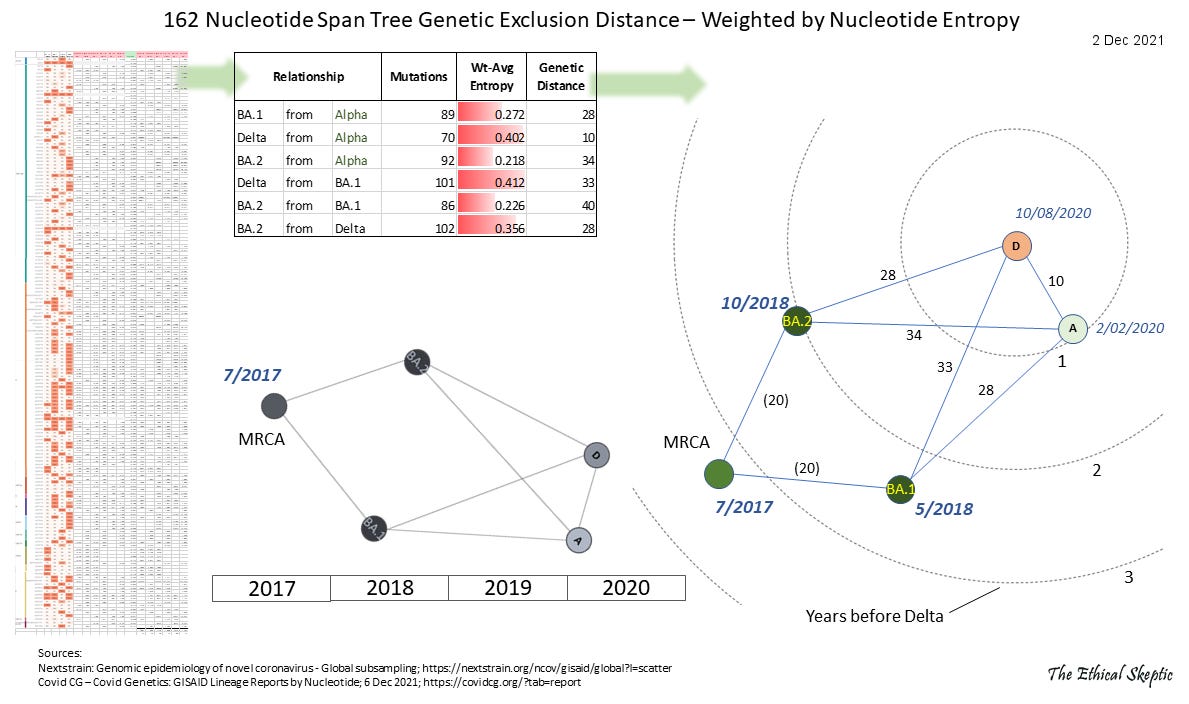
C. The Insufficient Absolute Mutation Rate of SARS-CoV-2
The absolute mutation rate of SARS-CoV-2 (both Omicron and Wuhan are measured as equal in the analysis below) stands in stark contrast to other cold and flu viruses, such as Influenza A and HCoV-NL63, both of which mutate at significantly higher rates. SARS-CoV-2, encompassing both “a” and “b” lineages in our vernacular, exhibits a mutation rate that is slow and stable, with an average rate of 1.45 × 10⁻⁴ mutations per week per clade. This measured and consistent rate places SARS-CoV-2 among the least mutationally dynamic respiratory viruses analyzed.
The implications of this slow mutation rate are profound. It renders the claim that Omicron evolved from the Wuhan strain (SARS-CoV-2b) within less than a year genetically implausible. Given the mutation potential of SARS-CoV-2, Omicron would require significantly more time to accumulate the mutations necessary to account for both its genetic distance from Alpha and its extensive internal diversity. The following chart compares SARS-CoV-2’s mutation rate to that of other respiratory viruses, further illustrating the improbability of a rapid Fall 2021 evolutionary development scenario for Omicron.
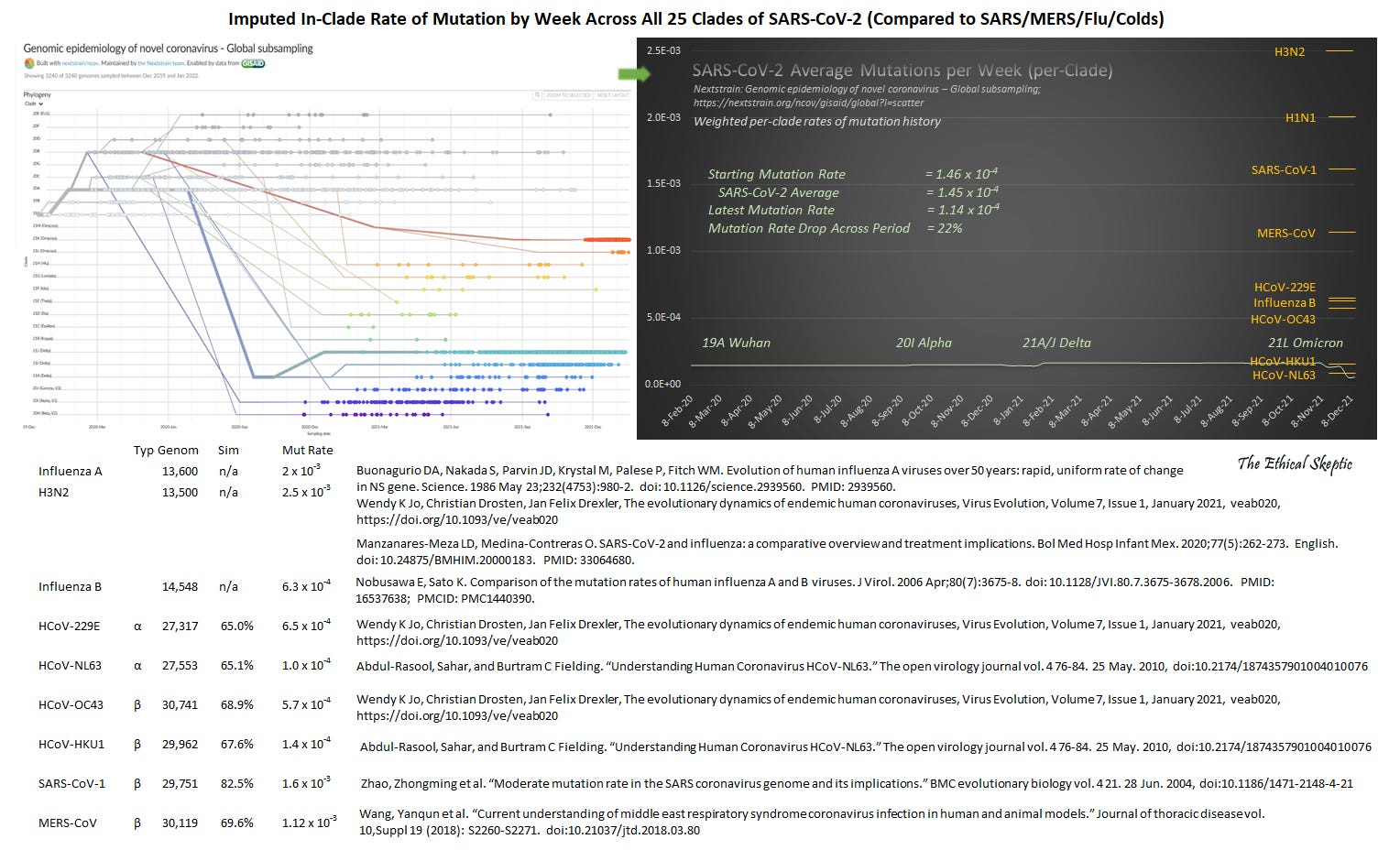
D. The Suddenly-Diverse Appearance of SARS-CoV-2b Wuhan in December 2019
In keeping with our argument regarding the insufficient absolute rate of mutation necessary to explain the sudden emergence of SARS-CoV-2a, Omicron, the emergence of SARS-CoV-2b in Wuhan similarly was not characterized by a singular, isolated strain. Rather, its detection was marked by a diverse set of genetically distinct clades. The slope of genetic divergence, as shown in the accompanying graphic (Exhibit D1 below), indicates that these variants did not suddenly arise within a single month. Instead, they reflect a longer evolutionary timeline that led to the observed diversity upon their detection.
This phylogenetic ‘learning curve’ (featuring a relatively slow mutation rate already measured in Section C above) highlights how SARS-CoV-2b likely circulated and diversified over an extended period before December 2019. The evidence challenges the notion of a rapid, localized outbreak and instead points to a broader and more complex evolutionary history for the virus, with roots that extend back significantly further in time. The following Exhibit D graphic illustrates this critical observation, tying genetic divergence to mutagenic potential and evolutionary trajectory.
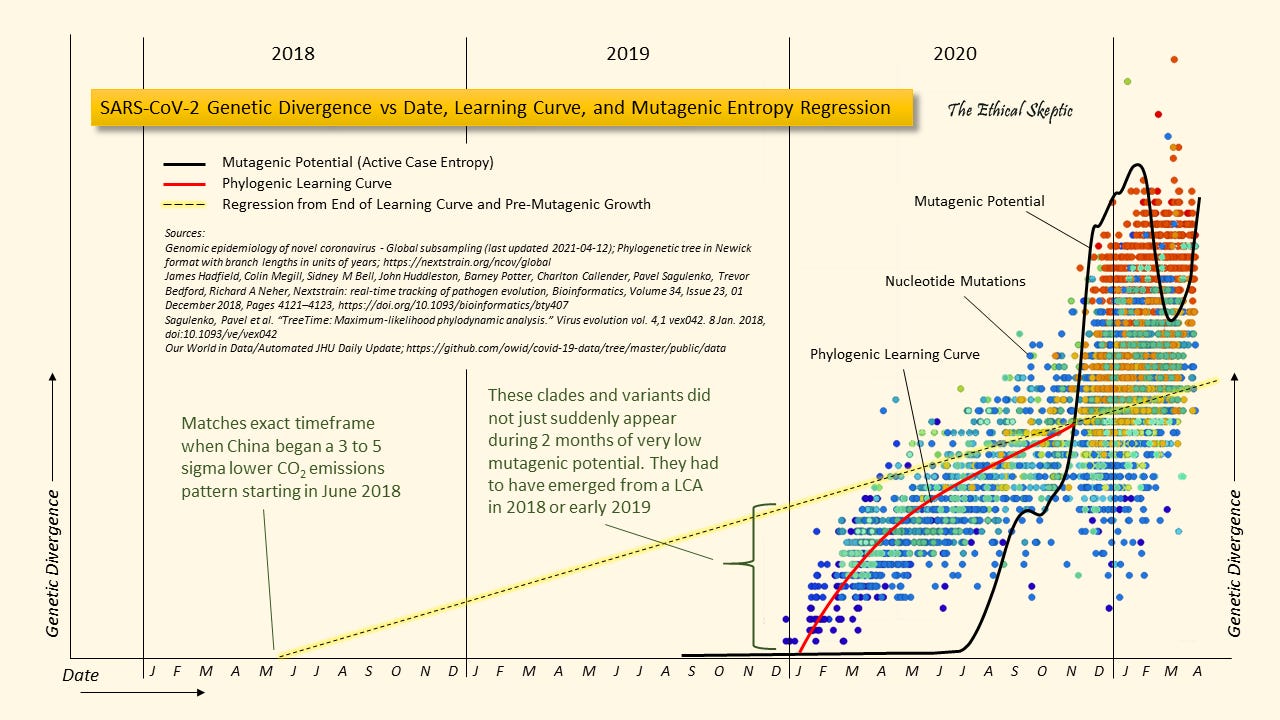
In addition, the taper of mutations in SARS-CoV-2b, relative to the naturally occurring precursor RaTG13 virus (Exhibit D2 below), suggests a far more complex timeline of origin for this set of clades than the simplistic explanations of a wet market spillover or a November 2019 Wuhan Institute of Virology accident. Neither scenario aligns with the genetic evidence. In fact, the July 2019 Wuhan “Respiratory Riots” emerge as a suspiciously well-fitting event within the genetic timeline, warranting closer scrutiny.
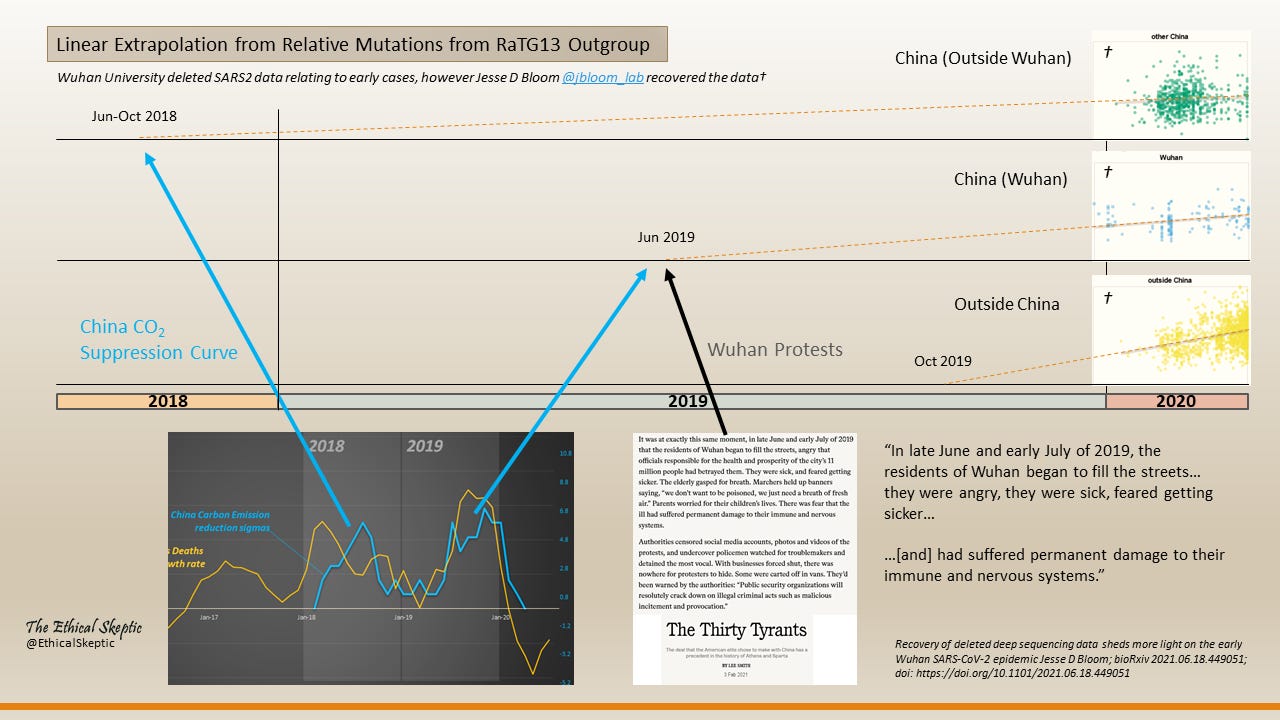
E. Insufficient Basis for Genetic Precursorship from Alpha-Delta to Omicron
A comparison of alleles between Alpha and Delta (Exhibit E1) reveals a direct relationship characterized by a high-entropy set of shared mutations, reflecting a natural evolutionary pathway between these two clades. However, when comparing both Alpha and Delta to Omicron (Exhibits E2 and E3), no such relationship exists. Omicron’s alleles stand apart, lacking the shared mutational patterns or entropy signatures that would suggest a direct evolutionary connection to either Alpha or Delta.
In Exhibit E1 we have made a prediction under our hypothesis, which is then confirmed by the observational evidence. Exhibits E2 and E3 then confirm the hypothesis premise itself.
This stark divergence further underscores the argument that Omicron did not emerge as a descendant of SARS-CoV-2b lineages like Alpha or Delta—especially given the allotted timeframe under the Narrative explanation of Omicron’s emergence. Instead, it points to an independent evolutionary pathway for Omicron, supporting the hypothesis of a long-hidden lineage that predates the emergence of both Alpha and Delta. The following graphics in Exhibits E1, E2, and E3 illustrate these allele comparisons, emphasizing the fundamental disconnect between Omicron (SARS-Cov-2a) and its supposed ancestral clades (SARS-CoV-2b).
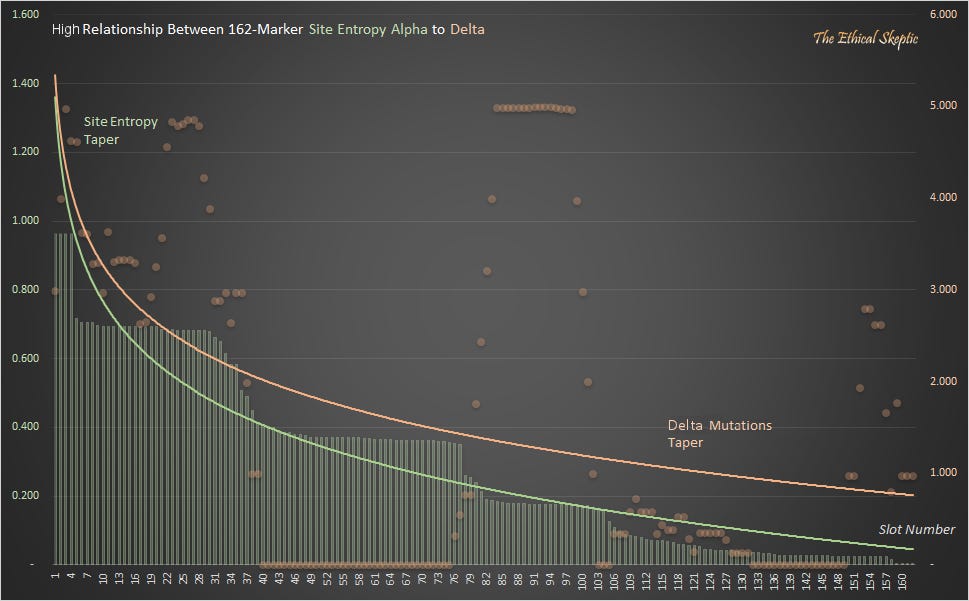
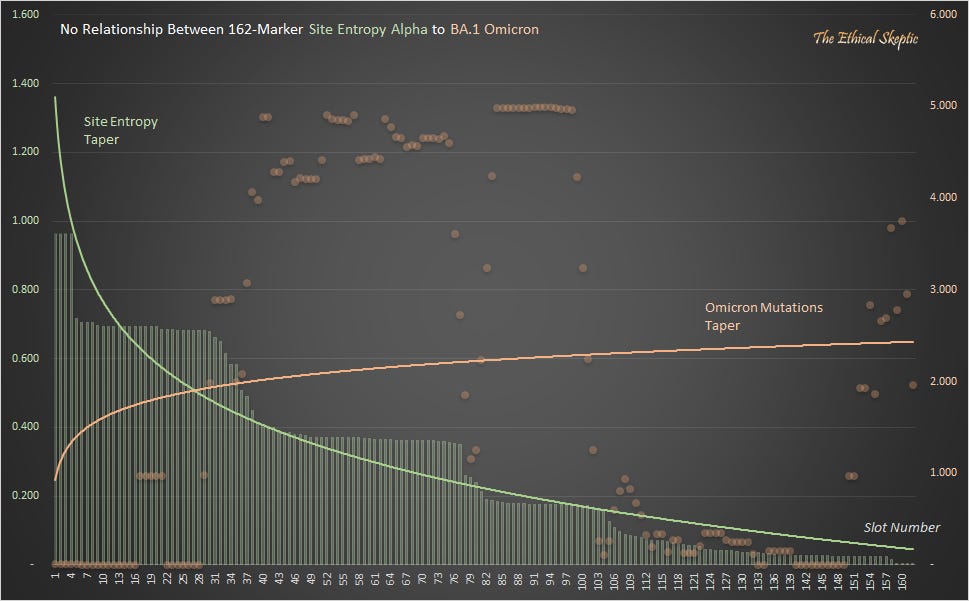
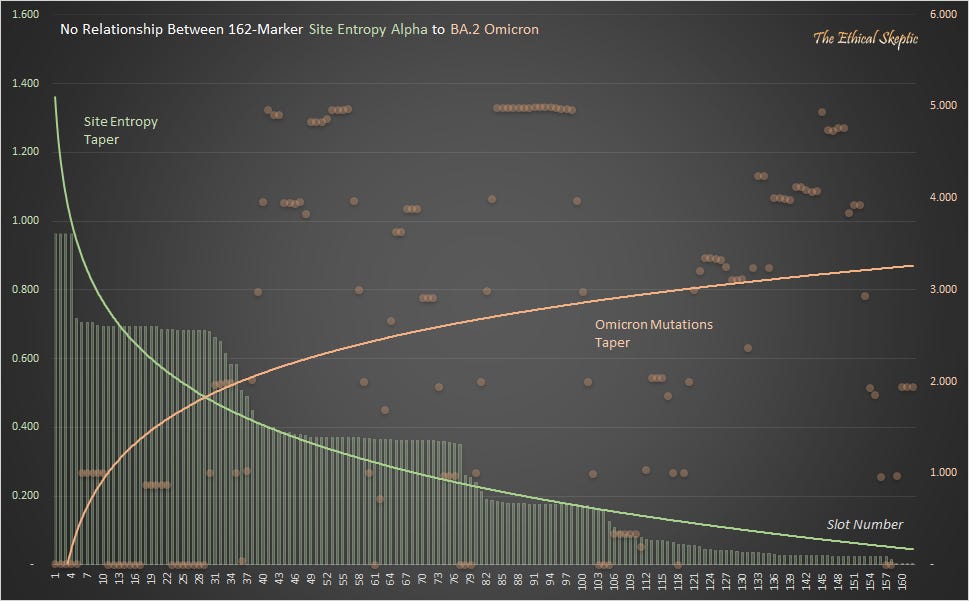
For that matter, even a comparison of BA.1 to BA.2 reveals that the two clades are not closely related at all. They bear a good 3 years of genetic distance between them (see Exhibit B).
F. Case Fatality Rate Bisected Linear Immunity Taper—Confirms Omicron’s Earlier Origin
The gradual taper in the global case fatality rate (CFR) aligns linearly with the rise in population immunity over time, presenting critical insights into the evolutionary timeline of SARS-CoV-2a (Omicron). By comparing these two linear tapers, this analysis reveals a consistent trajectory that cannot be reconciled with a late-2021 emergence for Omicron. Instead, it points to an earlier origin, where Omicron’s circulation and adaptation over time were already contributing to the observed CFR trends.
We were only able to bring this preexisting trend into coherence after SARS-CoV-2a (Omicron) had been observed for a sufficient amount of time. Once the two immunity tapers showed as parallel, a derivation date for BA.1 and BA.2 of mid-2017 could be both derived and confirmed.
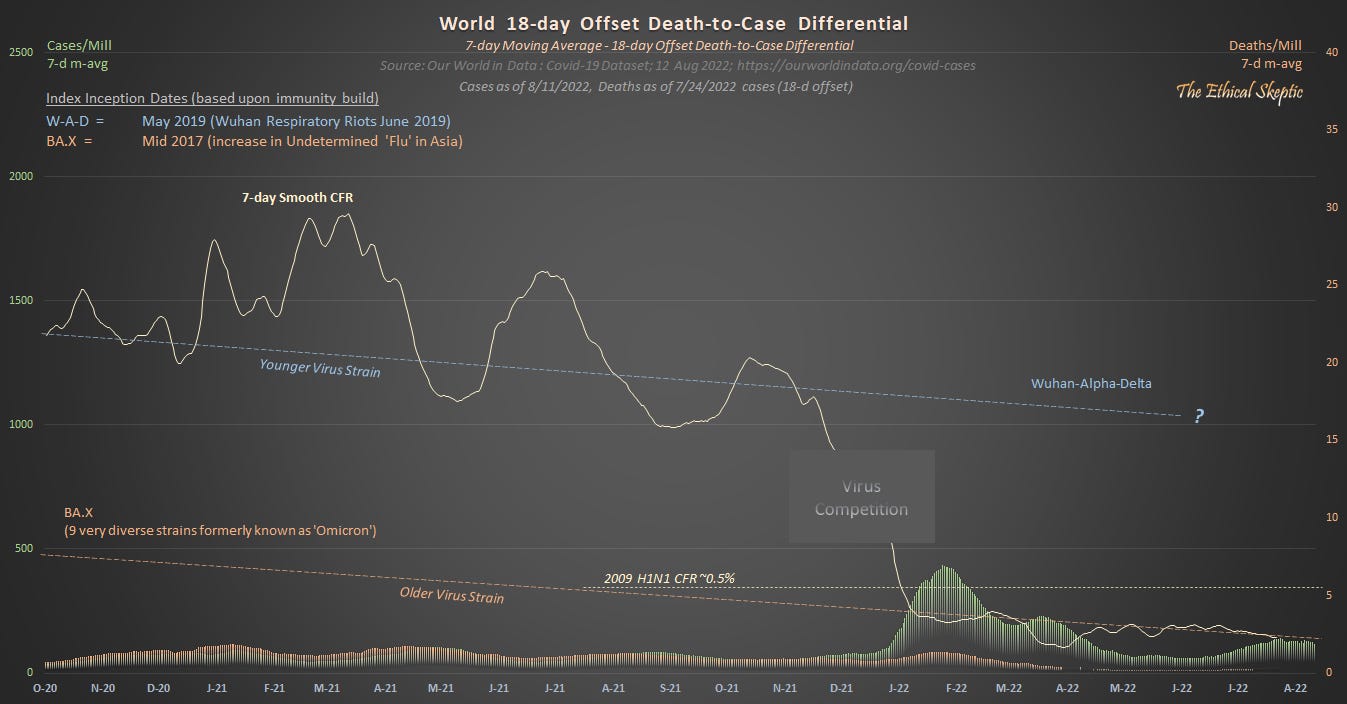
As the reader may observe in Exhibit F above, in much the same way that the precursor of Omicron imparted immunity to a majority of the global population prior to December 2019 (see Exhibit A), the resurgence (which human coronaviruses (HCoVs) naturally do every 3 to 6 years) of BA.1 and BA.2 served to halt, and potentially render extinct, the progression of SARS-CoV-2b (Wuhan-Alpha-Delta). This dynamic underscores the role of competing viral lineages in shaping immunity landscapes and ultimately driving the decline of dominant strains.
So, Why Are We Not Told This? A Tale of Two Pandemics
Remember, at the outset of this article we framed deductive evidence as constituting evidence which must be addressed by any hypothesis, and especially the official narrative on any given topic. Failure to address deductive observations, such as are provided in Sections A through F above, constitutes a key earmark of pseudoscience. Why then, is the pseudo-timeline of SARS-CoV-2’s origins framed so rigidly by the World Health Organization and US Public Health organizations? Why were alternative hypotheses and a number of studies suggesting early circulation (e.g., prior to December 2019) dismissed outright, even when supported by genetic, epidemiological, and statistical evidence?
(Omicron) SARS-CoV-2a Pandemic – Jul 2017 – Current
(Wuhan-Alpha-Delta) SARS-CoV-2b Pandemic – Jun 2019 – Apr 2022 (Extinct)
Evidence of prior immunity and pre-2019 circulation of SARS-CoV-2-like viruses has been marginalized precisely because of its deductive nature. If SARS-CoV-2a (BA.1 and BA.2 Omicron) is seen as a reference base for SARS-CoV-2b (Dec 2019 – Wuhan), then the specific pathways of genetic engineering entailed in the Gain-of-Function research schema of specific universities and institutions can be inferred from increased detection of various and long-extant global strains. Every new strain, variant, and clade therefore, must be novel by stipulation.
On October 17th 2014, then President Obama, who had commissioned creation of the SARS-CoV-2 virus, in a fit of virtuous appearances, issued a moratorium on Gain of Function research within the United States, which ended in July of 2016—while a the same time secretly shifting such research to China.
China's People's Liberation Army then quickly established and required compliance monitoring inside a shadow lab - using inferior and poorly-practiced Biosafety Level (BSL) standards of care - and released a number of dangerous viruses through their incompetence (SARS-Cov-2a and b were not the only gain-of-function-research-accident pandemics during these years).
This, we can never know - because the World Economic Forum and World Health Organizations are complicit in protecting China from world accountability. China's historic xenophobia has more to do with its role in eschatology than anything regarding its cultural proclivities. All of these entities seek the destruction of the United States in its current form as a part of that eschatology.
The Party in the United States is complicit with this because they stand to accrue a lot of money and power in the process of selling out their own fellow citizens. For example, both The Party and China were fully cognizant of the fentanyl-murder of 170,000 young US citizens—they just did not care—that is, until an election appeared to be going sideways on them.
Ethical skepticism isn’t about doubting for the sake of doubt or any form of ego-driven intellectual display—it’s about maintaining intellectual integrity towards ethical outcomes on behalf of those at risk. When the deductive evidence challenges the official Narrative and officials ignore such evidence, then the burden is not on dissidents to prove their case, but on the institutions to address the inconsistencies. The failure to do so invites cynicism and mistrust—such as manifested in the results of the 2024 Presidential Election—but also raises deeper questions about the motives and mechanisms driving this Narrative.
Perhaps American citizens turned out to not be as naïve or easily misled as the WHO, global Marxism, China, and The Party had anticipated. We were pleased to have played a key role in the evolution of such events.
The Ethical Skeptic, “”Omicron” Predated SARS-CoV-2 Wuhan by Years”; The Ethical Skeptic, WordPress, 13 Nov 2024; Web, https://theethicalskeptic.com/2024/11/13/omicron-predated-sars-cov-2-wuhan-by-years/







Given the unequal distribution of deaths worldwide I guess the question now is, “was US the target of a bioweapon?”
In my own work, i found that the Institutional Left’s response to c19 was far too quick to be organic: https://www.brookhines.com/p/the-devil-promised-disaster-socialism.
The timeline just won’t stack up—foundations would’ve ALL needed to spin up their campaigns in January, and then pump them out w/o much thought at all. Every single left org dropped their entire c19 campaign the week of Bernie/Biden debate—and it was used to back Bernie down.
For this to happen there had to be planning before Jan 1 2020, which I think is explained by some sort of Event 201 *VIP discussion.*
I think we’re left with only two options: either China targeted the US, or the US-elites targeted the US. I think if it were China there would be a counter-attack.
Many thanks for your pro bono service, TES.
I read your tweets re this matter.
If you have time, look at the the Australian Bureau of Statistics for ILI deaths - there was an unexplained spike in 2018-19. They were higher than in 2020-2023!